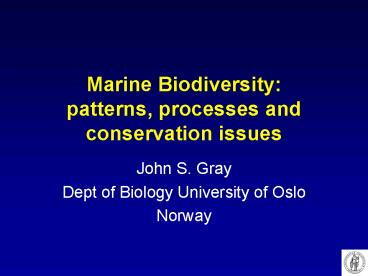Marine Biodiversity: patterns, processes and conservation issues - PowerPoint PPT Presentation
1 / 60
Title:
Marine Biodiversity: patterns, processes and conservation issues
Description:
... from high to low latitudes in communities of shelf benthos, and in the plankton' 2. 'In both benthic and water column assemblages the open sea tends to have more ... – PowerPoint PPT presentation
Number of Views:106
Avg rating:3.0/5.0
Title: Marine Biodiversity: patterns, processes and conservation issues
1
Marine Biodiversitypatterns, processes and
conservation issues
- John S. Gray
- Dept of Biology University of Oslo
- Norway
2
The Patterns
3
Marine Diversity Paradigms(from Levinton 1995 p
347-9)
- 1. The best known diversity gradient is an
increase of species diversity from high to low
latitudes in communities of shelf benthos, and in
the plankton - 2. In both benthic and water column assemblages
the open sea tends to have more species than do
inshore habitats - 3. Diversity of macroinvertebrates and fish
increases with depth to just seaward of the
continental rise and then decreases towards the
abyssal plain.
4
Sanders Diversity Data (1968)
5
Deep-sea data from New Jersey, USA, (Grassle
Maciolek 1992)
6
Frigg oilfield, Norway
7
Bass Strait, Australia
8
Species diversity of deep-sea
9
Species diversity of coastal sediments
10
Conclusions The Shallow-Deep Gradient
- The number of individuals per species is much
lower in the deep sea (mean 52) than at the coast
(mean 335 ) - Species density (number of species per unit area)
is higher in the deep sea than coast - Species richness decreases below 1500-2000m
- Coastal areas have a greater number of habitats
than the deep sesa and overall must have higher
species richness
11
Data (number of species) on which paradigm of the
Latitudinal Diversity Gradient is based
12
Latitudinal Diversity in the Deep Sea (Rex et al
1993)
13
Latitudinal gradient of estuarine benthos
(Attrill et al 2001)
14
Latitudinal Diversity Gradient(from Roy et al
1998)
15
Bivalve species richness (Crame, 2000)
16
Bivalve species richness (Crame, 2000)
17
Conclusions from Crames study
- Old bivalve clades do not show a latitudinal
gradient - Young clades (especially the heteroconchs) show
steep latitudinal gradients - This suggests that species arise, primarily in
the tropics (China-Indonesian region), and
radiate from here - Low Arctic species richness is probably because
the species have not yet reached there
18
Approximate species numbers in the Southern
Ocean, (from Arntz et al 1997)
19
Biodiversity of Norwegian continental shelf
(Ellingsen Gray 2001)
20
Alpha species richness
21
Species accumulation curvesNorwegian
continental shelf
22
Europe 125,000 b.p. Temperature 2oC warmer than
today (from Andersen Borns 1997)
23
Europe 20,000-17,000 years b.p.(from Andersen
Borns, 1997)
24
Europe and Arctic 15,000 years b.p.(from
Andersen Borns, 1997)
25
Europe and Arctic 11,000-10,000 years b.p. (from
Andersen Borns, 1997)
26
The ProcessesDoes more diversity lead to
increased rates of functional processes?
27
Species richness function(Naeem et al Nature
368 1994)
28
Species richness function (Naeem et al Nature
368 1994)
29
Species richness function (Naeem et al Nature
368 1994)
30
Species richness function(Emmerson et al. 2001
Nature)
31
Effect of species richness compared with single
species(Emmerson et al 2001 Nature)
32
Plant species and production(Schaffers 2002
Plant Ecology)
33
Endangered species and production(Schaffers 2002
Plant Ecology)
34
Rare species and production(Schaffers 2002 Plant
Ecology)
35
25 Biodiversity Hotspots(Myers et al 2000 Nature)
36
Conservation IssuesWhat aspects of marine
conservation do we need to emphasise?
37
The Threats to Marine Biodiversity
- Eutrophication (Red Tides)
- Effects of contaminants (especially oestrogenic
mimic hormones) - Habitat degradation, fragmentation and
destruction - Fishing and especially trawling
- Climate Change
38
Threats Red Tides
39
Imposex in Nucella lapillus
40
Frequency of Imposex in S.W England
41
Endocrine Disruptors
42
Habitat degradation Lamma beach
43
Reclamation ( coastal habitat destruction)
44
Reclamation Habitat destruction
45
The value of undisturbed coastal systems
(Costanza et al 1997 Nature)
- Estuaries US 22,832 ha-1 yr-1
- Seagrass algal beds US 19,004 ha-1 yr-1
- Tidal Marshes/mangroves US 9,990 ha-1 yr-1
- Swamps floodplains US 19,580 ha-1 yr-1
- Coral Reefs US 6,075 ha-1 yr-1
- Continental shelf US 1,610 ha-1 yr-1
- Total value of coastal services US 12,568 yr-1
x 109
46
The greatest threat Trawling
47
A full trawlPicture from Greenpeace Web site
www.greenpeace.org
48
Trawling Before
49
Trawling After
50
Trawling Before
51
Trawling After
52
Trawl marks on seabed (Side-scan sonar from
Thomas Lundalv)
53
Endemic species(Myers et al 2000 Nature)
54
Biodiversity of Norwegian continental shelf
(Ellingsen Gray 2001)
55
Species ranges Norwegian continental shelf
56
Species range Hong Kong(Data from Paul Shin)
57
Bivalve species richness (Crame, 2000)
58
Biodiversity and Human Populations(Cincotta et
al 2000 Nature)
59
Marine conservation in S.E.Asia
- Here is the greatest marine diversity in the
world - Human population and resulting environmental
pressures are extremely high - Intact coastal habitats are economically highly
valuable - Habitat destruction and degradation are the major
problems to be tackled
60
Marine conservation in S.E.Asia
- The focus needs to be on a wider range of species
than just e.g. dolphins and corals - Habitat preservation and restoration are the key
aspects of successful conservation - More research is needed on the patterns of
biodiversity and especially how species richness
changes with scale - Our latest research suggests that in sub-tropical
areas although regional species richness is
similar to that of temperate areas, richness
changes more rapidly with distance in subtropical
areas.































